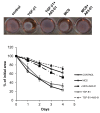Mast cells exert pro-inflammatory effects of relevance to the pathophyisology of tendinopathy
- PMID: 24517261
- PMCID: PMC3978883
- DOI: 10.1186/ar4374
Mast cells exert pro-inflammatory effects of relevance to the pathophyisology of tendinopathy
Abstract
Introduction: We have previously found an increased mast cell density in tendon biopsies from patients with patellar tendinopathy compared to controls. This study examined the influence of mast cells on basic tenocyte functions, including production of the inflammatory mediator prostaglandin E2 (PGE2), extracellular matrix remodeling and matrix metalloproteinase (MMP) gene transcription, and collagen synthesis.
Methods: Primary human tenocytes were stimulated with an established human mast cell line (HMC-1). Extracellular matrix remodeling was studied by culturing tenocytes in a three-dimensional collagen lattice. Survival/proliferation was assessed with the 3-(4,5-dimethylthiazol-2-yl)-5-(3-carboxymethoxyphenyl)-2-(4-sulfophenyl)-2H-tetrazolium salt (MTS) assay. Levels of mRNA for COX-2, COL1A1, MMP1, and MMP7 were determined by quantitative real-time polymerase chain reaction (qPCR). Cox-2 protein level was assessed by Western blot analysis and type I procollagen was detected by immunofluorescent staining. PGE2 levels were determined using an enzyme-linked immunosorbent assay (ELISA).
Results: Mast cells stimulated tenocytes to produce increased levels of COX-2 and the pro-inflammatory mediator PGE2, which in turn decreased COL1A1 mRNA expression. Additionally, mast cells reduced the type I procollagen protein levels produced by tenocytes. Transforming growth factor beta 1 (TGF-β1) was responsible for the induction of Cox-2 and PGE2 by tenocytes. Mast cells increased MMP1 and MMP7 transcription and increased the contraction of a three-dimensional collagen lattice by tenocytes, a phenomenon which was blocked by a pan-MMP inhibitor (Batimastat).
Conclusion: Our data demonstrate that mast cell-derived PGE2 reduces collagen synthesis and enhances expression and activities of MMPs in human tenocytes.
Figures







References
-
- Wygrecka M, Dahal BK, Kosanovic D, Petersen F, Taborski B, von Gerlach S, Didiasova M, Zakrzewicz D, Preissner KT, Schermuly RT, Markart P. Mast cells and fibroblasts work in concert to aggravate pulmonary fibrosis: role of transmembrane SCF and the PAR-2/PKC-alpha/Raf-1/p44/42 signaling pathway. Am J Pathol. 2013;15:2094–2108. doi: 10.1016/j.ajpath.2013.02.013. - DOI - PubMed
Publication types
MeSH terms
Substances
Grants and funding
LinkOut - more resources
Full Text Sources
Other Literature Sources
Medical
Research Materials
Miscellaneous

